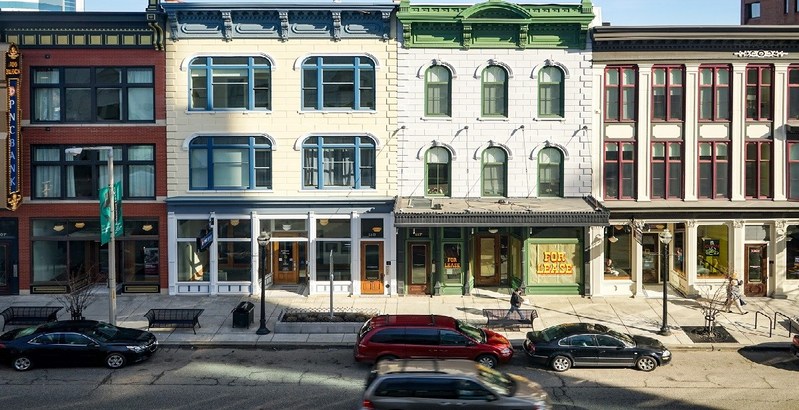
Kalamazoo, Michigan. By Neal Conway, Communications Manager, City of Kalamazoo (PRNewsfoto/Lincoln Institute of Land Policy)

Kalamazoo, Michigan. By Neal Conway, Communications Manager, City of Kalamazoo (PRNewsfoto/Lincoln Institute of Land Policy)
From Gary, Ind., to Lowell, Mass., smaller post-industrial cities are taking strategic steps to regenerate – with the chance to follow their larger rebounding counterparts like Pittsburgh and Cleveland – by building on downtowns, capitalizing on a unique sense of place, and focusing on workforce development, according to a new report published by the Lincoln Institute of Land Policy in partnership with the Greater Ohio Policy Center.
These smaller cities, with populations of 30,000 to 200,000, are reeling from the same loss of population and manufacturing jobs as Baltimore or Detroit, but they often lack the big universities, hospitals, or philanthropies that have boosted larger cities. They gained national attention when President Trump’s message resonated with voters who had long supported Democrats in cities like Scranton, Penn., hometown of former Vice President Joe Biden. Once powerhouses of the American economy, some now conjure images of abandoned steel mills and factories, and vacant houses and storefronts.
“The challenges faced by smaller legacy cities loom large in the American imagination,” authors Torey Hollingsworth and Alison Goebel of the Greater Ohio Policy Center write in Revitalizing America’s Smaller Legacy Cities: Strategies for Postindustrial Success from Gary to Lowell. “It’s no coincidence that Billy Joel and Bruce Springsteen chose Allentown, Penn., and Youngstown, Ohio, respectively, as symbols of the demise of a certain kind of American dream.”
The report makes the case for reinvesting in smaller legacy cities and explores strategies that have shown promise in some places. It examines 24 cities across seven midwestern and northeastern states: Michigan, Indiana, Ohio, Pennsylvania, New York, New Jersey, and Massachusetts. It measures each city’s progress from 2000-15 using a range of indicators, from employment to population change, and describes revitalization strategies that have succeeded thus far.
The cities differ greatly – some benefit from proximity to big cities like Philadelphia and New York, while others are more isolated – but they share much in common. They are grappling with persistent poverty, inequality, and blight, which were compounded by the Great Recession. They seek to attract young professionals and startups to become affordable alternatives to hot market cities, but they also need to nurture their existing populations across all incomes and skill levels. They first rose to prosperity amid a wave of immigration, and many recognize the role of immigrants in their resurgence a century later.
“No two places are alike, but smaller legacy cities can learn from each other as they reposition themselves, whether as a regional service center, a competitor on the national or global stage, or a tourism hub,” the authors said. “They will need to build teams from the public and private sectors who share a spirit of collaboration and the will to lead their communities through a period of great transformation.”
The report recommends eight strategies for revitalization that have shown promise in some places:
- Build civic capacity and talent: Cities like South Bend, Ind., and Hamilton, Ohio, created fellowships to place talented young workers in management-level positions in the private and public sectors, and Hamilton recruited a city manager from outside the city to change the culture of City Hall.
- Encourage a shared public- and-private-sector vision: In Lancaster, Penn., the private sector led the deployment of a plan that reimagined the city as a tourist hub, and in Grand Rapids, Mich., business leaders created an organization that revitalized the central business district.
- Expand opportunities for low-income workers: Lima, Ohio, has created an umbrella organization to coordinate workforce development efforts, and in Syracuse, N.Y., the regional chamber of commerce tied a redevelopment project to high-paying jobs and skills training.
- Build on an authentic sense of place: Bethlehem, Penn., converted part of a closed steel plant into an arts and cultural campus, and Scranton encouraged former residents who had moved to New York or other large cities to return home, emphasizing quality of life.
- Focus regional efforts on rebuilding a strong downtown: Syracuse prioritized downtown revitalization efforts to help create jobs and attract talented workers, and York, Pennsylvania, created a business improvement district to re-create the downtown as a retail center.
- Engage in community and strategic planning: Grand Rapids encourages neighborhoods to create plans to guide new development, while Dayton, Ohio, and Flint, Michigan, have engaged residents in tough conversations about future land use after extreme population losses.
- Stabilize distressed neighborhoods: Youngstown used data to pinpoint struggling neighborhoods and prioritize funding to triage housing in poor condition.
- Strategically leverage state policies: Ohio authorized counties to create local land banks to respond to the vacancy and foreclosure crisis, and Massachusetts is collaborating with a statewide think tank to direct resources to targeted legacy cities.
Revitalizing America’s Smaller Legacy Cities is a follow-up to the Lincoln Institute’s 2013 report, Regenerating America’s Legacy Cities, which focuses on larger cities such as Detroit, Baltimore, Cincinnati, and Pittsburgh. It marks the latest step in the Lincoln Institute’s ongoing initiative to help build the capacity of legacy cities to thrive in the 21st century, and to ensure that all residents enjoy the benefits of revitalization.
